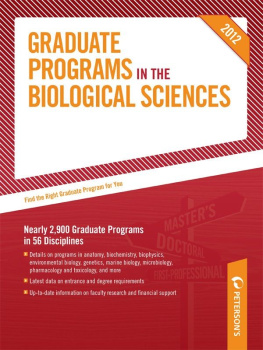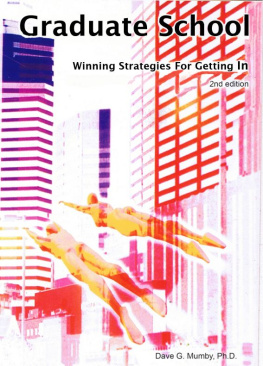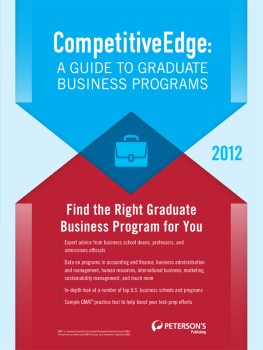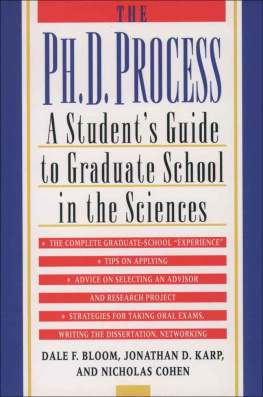The Graduate School Funding Handbook
Third Edition
The
Graduate School
Funding Handbook
Third Edition
April Vahle Hamel, Ph.D., and Jennifer S. Furlong, Ph.D.

Copyright 2012 April Vahle Hamel
All rights reserved. Except for brief quotations used for purposes of review or scholarly citation, none of this book may be reproduced in any form by any means without written permission from the publisher.
Published by
University of Pennsylvania Press
Philadelphia, Pennsylvania 19104-4112
www.upenn.edu/pennpress
Printed in the United States of America on acid-free paper
10 9 8 7 6 5 4 3 2 1
Library of Congress Cataloging-in-Publication Data
Hamel, April Vahle.
The graduate school funding handbook / April Vahle Hamel and Jennifer S. Furlong. 3rd ed.
p. cm.
Includes bibliographical references.
ISBN 978-0-8122-2169-5 (pbk. : alk. paper)
1. Universities and collegesUnited StatesGraduate workFinance.
2. Graduate studentsScholars
LB2371.4.H35 2012
378.3'30973dc23
2011025252
Contents
Jennifer S. Furlong
Preface to the Third Edition
This third edition of The Graduate School Funding Handbook contains new and updated information. All the grants, fellowships, and scholarships offered by the government and private institutions have been thoroughly researched, revised, and brought up to date. Some funding opportunities listed in the first and second editions have been removed because they are no longer offered, while others have been reviewed and rewritten. Information on new awards has been added.
Chapter 1
Graduate Degrees and Institutional Financial Aid
Types of Graduate Degrees
In 2009, more than 1.75 million students were enrolled in graduate certificate, education specialist, masters, and doctoral programs in the arts and sciences within the United States. In addition, another 190,000 students were in M.B.A. and other related business programs; 65,000 were in medical school; and 150,000 were busy pursuing law-school degrees. Of currently enrolled students, 90 percent can be found in traditional, on-campus programs at established masters and doctoral degree-granting universities, while the rest participate in some form of distance learning over the Internet or by mail.
Graduate programs have been classified into general categories described below.
Masters Degrees
Applied/Professional Masters Programs
Applied/professional masters programs require one to three years of course work and are meant to prepare people for careers in such professions as business (M.B.A.), teaching (M.A.T.), and social work (M.S.W.).
Many professional masters programs require an internship or other hands-on experience as part of the curriculum. Experience after college and before graduate school is highly desirable, which means scholars in these disciplines may be older, returning students.
Research Masters Programs
Research masters programs require one to two years of course work and are designed to enhance research experience begun in undergraduate school. Some programs require a long research paper called a thesis, and most expect successful completion of written or oral examinations. Most research masters programs (M.A., M.S.) in the arts and sciences fall into this category.
Creative Masters Programs
Creative masters programs last two to three years and are intended to expand on creative work started in undergraduate school or through experience. Painters, musicians, poets, and artists of all sorts are attracted to programs in fine arts (M.F.A.), music (M.M.), writing and poetry (M.F.A.W.), and others. Creative masters programs usually require a special project, such as a book of poetry, a recital, or an exhibition, as part of the curriculum.
Doctoral Degrees
Applied/Professional Doctoral Programs
Applied/professional doctoral programs, such as those found in business (D.B.A.), medicine (M.D., O.D.), law (J.D.), and education (Ed.D.), like their masters counterparts, are designed to develop a corps of new professionals who apply their skills in a hands-on style. While some may teach or do research in college or university settings, most intend to practice outside an academic setting. The length of study ranges from three to five years and usually requires postdoctoral experience or passing a national or state licensing examination, or both.
Research Doctoral Programs
Research doctoral programs culminate in the awarding of the Ph.D. or Sc.D. degree. Most research doctoral degrees are awarded in arts and sciences and in engineering, but they are also available in business, social work, and other professional areas. Students enrolled in these programs usually intend to do research in higher education, industry, or government, or they aim to teach and do research at the college or university level.
Combined Degree Programs
Combining an applied with a research degree program is common. A medical student may also pursue a Ph.D. in a biomedical area or a law student a masters in an arts and sciences field. Usually, applications are submitted to both programs simultaneously, and the applicant must be accepted to both.
Certificates
Certificates may be required to satisfy state or other agency requirements. Teachers in public education need certificates to teach, do counseling, and administrate. Other certificates may not lead to licensing or a degree but may be a universitys way of recognizing the acquisition of a skill set or information in a particular area.
Degree Program Enrollment, Time to Degree, Career Status, Cost
Everyone interested in enrolling in a graduate program should investigate four areas. The first is degree program enrollment. The number of openings in graduate-school programs rises and falls from year to year and decade to decade. In 2008, the American Association of Medical Colleges projected that the available slots in medical schools will increase 21 percent by 2012. That is an increase of 3,400 students per year. Since the passage of the 2010 federal health-care bill, it would not be surprising to see that percentage go even higher. This increase means that the chances of getting into medical school currently and in the near future have improved over previous years.
The second important consideration in looking at graduate programs is time to degree. How long will it take to get a degree? While most professional programs have standard lengths of time that almost all students adhere to, such as three years of law school and four of medical school, time to degree in other programs is not so clearly defined. A 2010 article in the New York Times Education section reported the following: The median age of a recipient of a humanities doctorate is 35, with an average education-related debt of $23,315.
Average Time to Completion (Doctoral Degree) in Each Field, 2008 |
Engineering | 6.7 years |
Physical Sciences | 6.7 years |
Life Sciences | 6.9 years |
Social Sciences | 7.7 years |
Humanities | 9.3 years |
Other Fields | 9.3 years |
Next page





